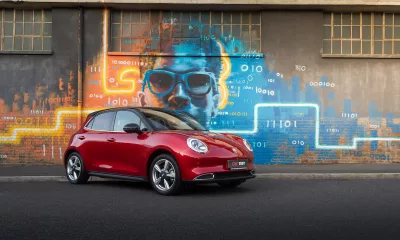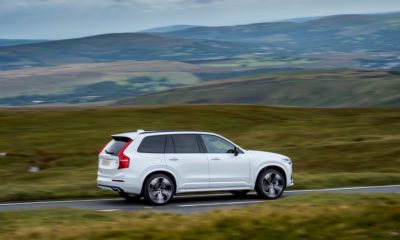AUDI and BMW’s South African operations should be shaking in their boots. For years, they’ve had the market for premium compact SUVs cornered with the Q5 and X3. Notable by its absence was Mercedes-Benz; its GLK was offered only in left-hand drive (re-engineering it for right-hand-drive markets, which constitute but a fraction of global sales volume, would have been too costly).
The other Germans’ dominance looks likely to be upset by the vehicle on these pages. Built on Mercedes-Benz’s new Modular Rear Architecture (MRA) platform, which underpins the C-Class and will form the base of the upcoming E-Class, Stuttgart’s engineers have been able to adapt the vehicle for right-hand-drive markets such as South Africa, the United Kingdom and Australia. Add surprisingly competitive pricing across the range of four models and the GLC has all the makings of a smash hit.
Buyers will certainly be drawn to showroom floors by the design. Eschewing the GLK’s blocky, opinion-splitting looks in favour of an amalgamation of modern Benz styling cues, the vehicle looks smart, balanced and chic. Our test GLC300 – the flagship model until the GLC450 AMG Sport and GLC63 make their debut – benefits from the addition of an AMG Sport Exterior package at R35 000 that options larger alloys (although this vehicle goes one step further and upgrades the 19-inch units to 20-inchers) and revised bumpers front and rear, among others. We’d avoid the optional aluminium-look running boards alongside the sills, as they’re chunky enough to soil calves when getting in and out of the vehicle.
The real success, however, lies within. These pages have been filled with glowing reviews of recent Benz cabins, and the GLC likewise deserves praise … but with a few qualifications, which we’ll get to. Design-wise, it borrows heavily from the C-Class in its basic layout, including the latter’s facia, instruments and controls.
But, thanks to a lengthened wheelbase (by 37 mm) and taller cabin, there’s satisfactory room for all occupants. In typical Benz style, the driving position is widely adjustable – one, ahem, shorter tester pushed the seat all the way back and then couldn’t reach the pedals – and the firm front seats are snugly supportive. Rear legroom bests that of the C-Class by a measured 33 mm and the rear quarters offer 51 mm extra scalp clearance. In fact, the GLC is nearly as spacious as the GLE in the rear, although it doesn’t offer as much shoulderroom.
Ostensibly to create as much seating comfort for occupants as possible, boot space has taken a knock. Measuring 280 dm3, it’s smaller by 72 dm3 than that of its main rival, the X3. Fold the rear seats, which is easy to do thanks to buttons sited inside the cabin on the rear wheelarches instead of tugging on a hefty lever, and the cabin provides a still-less-competitive 1 112 dm3.
So the GLC isn’t as big inside as the X3, but it comprehensively trounces it on perceived quality. Despite being equipped with leatherette instead of the real deal (which costs R14 900), the cabin creates a real sense of class through beautifully grained soft-touch plastic and metallic switches, where the BMW is lumbered with a bland design and humdrum materials.
However, as alluded to before, it isn’t perfect. This test unit’s facia exhibited creaks over rough road surfaces and the rear doors feature soft-touch padding only on the upper sections; the door pockets are lined in cheap-feeling plastic. Pop the nine-speed automatic transmission in reverse and the rear-view camera noisily slides out from under the Benz badge; meanwhile, the centre armrest groans when elbow pressure is added. These are small niggles, sure, but they knock the impression of quality.
In terms of standard specification, all GLCs feature climate control, auto lights and wipers, part-electric adjustment on the front seats and a comprehensive infotainment system with two USB ports and Bluetooth. Comand sat-nav is a pricey option at R24 500, but the system has been refined to such a degree that it matches BMW’s segment-standard iDrive system for usability. Likewise, an upgraded 13-speaker, 590 W Burmester audio system is optional, but is excellent value at R10 000.
A further must is the optional Air Body Control air-suspension system (R14 000). As we’ve found with passively suspended C-Classes, suspension employed on the MRA platform are tuned to provide a stable, flat ride at high speeds, slightly compromising rolling comfort at a slower pace. However, the air suspension addresses this concern and provides a wonderfully loping ride quality when the Dynamic Select damper setup is left in comfort mode. The air-suspension system, like others that use this technology, can get flummoxed when presented with a series of short, sharp intrusions, but considering the test unit rode on 20-inch wheels and 45-profile run-flat tyres, the ride is remarkably composed.
That fits in perfectly with the vehicle’s overall refined air. Wind and road noise are so well suppressed that we’re not quite sure why anyone would stump up R3 600 for noise-insulating side glass. Equally, the steering is excellent – direct, quick and light – and the 2,0-litre turbocharged petrol engine barely makes itself heard when the throttle is used conservatively. In more enthusiastic driving, its gruff nature turns more noticeable, but it’s never intrusive.
It’s just as well it doesn’t threaten and bluster, because it doesn’t propel the near-1,9-tonne GLC300 with great enthusiasm. A 0-to-100 km/h sprint time of 8,01 seconds is quick enough, but in-gear acceleration is sufficient rather than strong. We suspect the GLC250d will be quicker through the gears.
The nine-speed automatic transmission mostly does an excellent job of selecting the right ratio to keep the four-cylinder engine in the meat of its 1 200 to 4 000 r/min torque band, but it too has its faults. Like Benz’s unloved (in these quarters, at least) seven-speed transmission, it displays the odd clunk when the vehicle comes to a standstill or when a sudden increase in acceleration is called upon. We’ve said it before, but it bears repeating: perhaps it’s time for the manufacturer to start employing a supplier-developed transmission, such as ZF’s excellent eight-speed unit.
Completing the dynamic repertoire are brakes that, although they didn’t perform quite as well in our 10-stop emergency test procedure as other recent Benzes, provide fuss-free, predictable braking in daily running. Complementing the ABS system are seven airbags, ESP and a suite of safety features as part of the carmaker’s Intelligent Drive assistance package. This can be enhanced with the Driving Assistance Plus package (R29 900) with such features as lane-departure warning and blind-spot assist.









